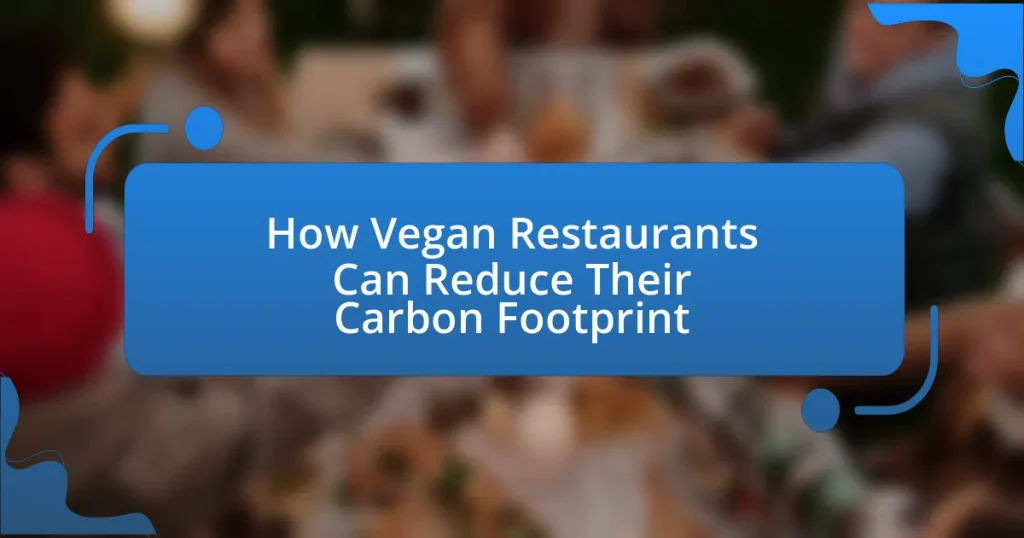Vegan restaurants play a crucial role in reducing their carbon footprint through various sustainable practices. By sourcing local and seasonal plant-based ingredients, these establishments can significantly minimize transportation emissions and greenhouse gas outputs associated with food production. The article explores the primary sources of carbon emissions in the restaurant industry, including energy consumption, food sourcing, and waste management, while highlighting the environmental benefits of plant-based diets. Additionally, it discusses practical strategies for vegan restaurants to enhance sustainability, such as implementing energy-efficient practices, waste reduction initiatives, and engaging customers in eco-friendly behaviors. Overall, the article emphasizes the importance of sustainability in the vegan restaurant sector to combat climate change and promote a more responsible food system.

How Can Vegan Restaurants Contribute to Reducing Their Carbon Footprint?
Vegan restaurants can significantly reduce their carbon footprint by sourcing plant-based ingredients locally, minimizing transportation emissions. By prioritizing local produce, these establishments can cut down on the greenhouse gases associated with long-distance food transport, which accounts for approximately 11% of total food-related emissions in the United States. Additionally, vegan restaurants typically require less energy and resources for food production compared to meat-based options; for instance, producing plant-based foods generates up to 50% fewer greenhouse gas emissions than animal products. Implementing sustainable practices, such as composting food waste and using eco-friendly packaging, further enhances their environmental impact. Collectively, these strategies contribute to a lower carbon footprint and promote a more sustainable food system.
What are the primary sources of carbon emissions in the restaurant industry?
The primary sources of carbon emissions in the restaurant industry include energy consumption, food sourcing, and waste management. Energy consumption, particularly from cooking equipment and heating, contributes significantly to emissions; for instance, commercial kitchens often rely on gas and electricity, which can produce substantial greenhouse gases. Food sourcing is another major factor, as the transportation and production of ingredients, especially meat and dairy, generate high levels of carbon emissions; studies indicate that animal-based foods have a larger carbon footprint compared to plant-based options. Lastly, waste management practices, including food waste and packaging disposal, also contribute to emissions, with food waste alone accounting for approximately 8-10% of global greenhouse gas emissions.
How do food sourcing practices impact carbon emissions?
Food sourcing practices significantly impact carbon emissions by determining the distance food travels, the methods of production, and the types of ingredients used. For instance, sourcing local produce reduces transportation emissions, as food does not need to be shipped over long distances, which can account for up to 11% of total greenhouse gas emissions in the food supply chain. Additionally, sourcing organic or sustainably farmed ingredients typically results in lower emissions compared to conventional farming, as these practices often use fewer synthetic fertilizers and pesticides, which are energy-intensive to produce. Studies indicate that plant-based diets, which are central to vegan restaurants, can reduce carbon footprints by up to 70% compared to meat-based diets, highlighting the importance of sourcing plant-based ingredients.
What role does energy consumption play in a restaurant’s carbon footprint?
Energy consumption significantly contributes to a restaurant’s carbon footprint, accounting for a substantial portion of greenhouse gas emissions. Restaurants utilize energy for cooking, heating, cooling, and lighting, which often relies on fossil fuels, leading to increased carbon dioxide emissions. For instance, the U.S. Environmental Protection Agency estimates that commercial buildings, including restaurants, contribute approximately 17% of total greenhouse gas emissions in the United States. By optimizing energy use through energy-efficient appliances and renewable energy sources, restaurants can reduce their carbon footprint and mitigate environmental impact.
Why is it important for vegan restaurants to focus on sustainability?
Vegan restaurants must focus on sustainability to minimize their environmental impact and promote ethical consumption. By sourcing ingredients locally and using sustainable practices, these establishments can significantly reduce carbon emissions associated with food transportation and production. For instance, a study published in the journal “Environmental Science & Technology” found that plant-based diets can reduce greenhouse gas emissions by up to 70% compared to meat-based diets. This alignment with sustainability not only attracts environmentally conscious consumers but also contributes to the broader goal of combating climate change.
How does the vegan diet inherently reduce carbon emissions?
The vegan diet inherently reduces carbon emissions by eliminating animal agriculture, which is a significant contributor to greenhouse gas emissions. Animal farming produces approximately 14.5% of global greenhouse gas emissions, primarily through methane from livestock and nitrous oxide from manure management. In contrast, plant-based foods generally require fewer resources and produce lower emissions during production. For instance, producing one kilogram of beef can generate up to 27 kilograms of CO2 equivalent, while producing one kilogram of vegetables typically results in less than 2 kilograms of CO2 equivalent. Thus, adopting a vegan diet directly contributes to lower carbon emissions by reducing the demand for resource-intensive animal products.
What are the environmental benefits of plant-based ingredients?
Plant-based ingredients significantly reduce environmental impact by lowering greenhouse gas emissions, conserving water, and preserving biodiversity. Research indicates that plant-based diets can reduce carbon emissions by up to 50% compared to meat-based diets, as livestock farming is responsible for approximately 14.5% of global greenhouse gas emissions. Additionally, producing plant-based foods typically requires less water; for instance, producing one kilogram of beef requires about 15,000 liters of water, while one kilogram of vegetables requires only around 300 liters. Furthermore, plant-based agriculture promotes biodiversity by reducing the need for land conversion, which is a major driver of habitat loss.
What strategies can vegan restaurants implement to minimize their carbon footprint?
Vegan restaurants can minimize their carbon footprint by sourcing ingredients locally, which reduces transportation emissions. By prioritizing seasonal produce, these establishments can further decrease their environmental impact, as seasonal foods typically require less energy for growth and transportation. Implementing energy-efficient appliances and practices, such as LED lighting and smart thermostats, can significantly lower energy consumption. Additionally, adopting a zero-waste policy, which includes composting food scraps and minimizing single-use plastics, contributes to reducing landfill waste and associated emissions. According to a study by the Food and Agriculture Organization, local sourcing can cut food miles by up to 90%, demonstrating a clear link between sourcing practices and carbon footprint reduction.
How can local sourcing of ingredients reduce transportation emissions?
Local sourcing of ingredients can significantly reduce transportation emissions by minimizing the distance food travels from farm to table. When ingredients are sourced locally, the reliance on long-haul transportation methods, which often involve fossil fuel consumption, is decreased. For instance, a study by the USDA found that food transported over long distances can generate up to 11 times more greenhouse gas emissions compared to locally sourced food. By shortening the supply chain, local sourcing not only cuts down on fuel usage but also reduces the overall carbon footprint associated with food distribution.
What energy-efficient practices can be adopted in vegan kitchens?
Energy-efficient practices that can be adopted in vegan kitchens include using energy-efficient appliances, optimizing cooking methods, and implementing waste reduction strategies. Energy-efficient appliances, such as induction cooktops and Energy Star-rated refrigerators, consume less electricity, thereby reducing overall energy usage. Optimizing cooking methods, like using pressure cookers or slow cookers, can significantly decrease cooking time and energy consumption. Additionally, implementing waste reduction strategies, such as composting organic waste and minimizing food waste through careful inventory management, can further enhance energy efficiency by reducing the energy required for waste disposal. These practices collectively contribute to a lower carbon footprint in vegan kitchens.

What are the challenges vegan restaurants face in reducing their carbon footprint?
Vegan restaurants face several challenges in reducing their carbon footprint, primarily related to sourcing ingredients, energy consumption, and waste management. Sourcing local and organic produce can be difficult due to seasonal availability and higher costs, which may lead to reliance on imported goods that have a larger carbon footprint. Additionally, energy consumption in kitchens, particularly from cooking methods and equipment, contributes significantly to emissions; many vegan restaurants may not have access to renewable energy sources. Waste management poses another challenge, as composting and recycling systems may not be readily available or efficient, leading to increased landfill contributions. These factors collectively hinder the ability of vegan restaurants to minimize their environmental impact effectively.
How do cost considerations affect sustainability efforts?
Cost considerations significantly influence sustainability efforts by determining the feasibility and implementation of eco-friendly practices. For instance, vegan restaurants may face higher initial costs when sourcing organic ingredients or investing in energy-efficient appliances, which can deter them from adopting sustainable methods. A study by the Food and Agriculture Organization indicates that while sustainable practices may incur upfront expenses, they often lead to long-term savings through reduced waste and energy consumption. Therefore, the financial implications of sustainability initiatives can either promote or hinder their adoption in the restaurant industry.
What are the financial implications of sourcing local versus imported ingredients?
Sourcing local ingredients generally results in lower transportation costs and supports the local economy, while imported ingredients often incur higher shipping fees and tariffs. Local sourcing can reduce overall expenses by minimizing logistics and spoilage, as products are fresher and have a shorter supply chain. In contrast, imported ingredients may offer lower prices per unit but can lead to increased costs due to transportation and potential import duties. According to a study by the USDA, local food systems can enhance economic resilience by keeping more money within the community, which can be particularly beneficial for vegan restaurants aiming to align their financial practices with sustainability goals.
How can vegan restaurants balance quality and sustainability?
Vegan restaurants can balance quality and sustainability by sourcing local, organic ingredients that minimize transportation emissions while ensuring freshness and flavor. Utilizing seasonal produce not only supports local farmers but also reduces the carbon footprint associated with long-distance food transport. Research indicates that local food systems can cut greenhouse gas emissions by up to 30% compared to conventional supply chains. Additionally, implementing waste reduction practices, such as composting and utilizing biodegradable packaging, further enhances sustainability without compromising the quality of the dining experience. By prioritizing these strategies, vegan restaurants can effectively align their operational practices with both high-quality offerings and sustainable principles.
What barriers exist in consumer awareness and demand for sustainable practices?
Barriers in consumer awareness and demand for sustainable practices include lack of information, perceived higher costs, and limited accessibility. Many consumers are unaware of the environmental impact of their choices, as studies show that 70% of individuals do not understand the benefits of sustainable practices. Additionally, consumers often believe that sustainable products are more expensive, which deters them from making eco-friendly choices; research indicates that 60% of consumers cite cost as a significant barrier. Furthermore, limited availability of sustainable options in local markets restricts consumer access, with only 30% of grocery stores offering a wide range of sustainable products. These factors collectively hinder the growth of consumer demand for sustainable practices.
How can education and marketing influence customer choices?
Education and marketing significantly influence customer choices by shaping perceptions and providing information that guides decision-making. Educational initiatives, such as awareness campaigns about the environmental benefits of vegan diets, inform customers about the positive impact of their food choices on carbon footprints. Marketing strategies, including targeted advertising and social media engagement, highlight these benefits, making vegan options more appealing. For instance, studies show that consumers are more likely to choose plant-based meals when they understand their lower environmental impact, as evidenced by research from the Journal of Consumer Research, which found that informed consumers are 30% more likely to select sustainable food options.
What role does community engagement play in promoting sustainability?
Community engagement plays a crucial role in promoting sustainability by fostering collective action and awareness among individuals. Engaged communities are more likely to adopt sustainable practices, such as reducing waste and supporting local food systems, which directly contribute to lower carbon footprints. Research indicates that community-led initiatives, like local clean-up events or educational workshops, can significantly enhance participation in sustainability efforts, leading to measurable environmental benefits. For instance, a study published in the Journal of Environmental Management found that communities with active engagement programs saw a 30% increase in recycling rates compared to those without such initiatives. This demonstrates that when individuals collaborate and share knowledge, they can effectively drive sustainable change.
How can vegan restaurants measure their carbon footprint effectively?
Vegan restaurants can measure their carbon footprint effectively by utilizing a combination of carbon footprint calculators, life cycle assessments (LCAs), and tracking specific metrics such as energy consumption, waste production, and ingredient sourcing. Carbon footprint calculators, such as those provided by organizations like the Carbon Trust, allow restaurants to input data related to their operations and receive an estimate of their greenhouse gas emissions. Life cycle assessments provide a comprehensive analysis of the environmental impact of food items from production to disposal, enabling restaurants to identify high-impact ingredients. Additionally, tracking metrics like energy usage from cooking equipment and the amount of food waste generated can help pinpoint areas for improvement. Research indicates that food production accounts for approximately 25% of global greenhouse gas emissions, highlighting the importance of accurate measurement in reducing overall impact.
What tools and metrics are available for carbon footprint assessment?
Tools and metrics available for carbon footprint assessment include the Greenhouse Gas Protocol, Life Cycle Assessment (LCA) software, and carbon calculators. The Greenhouse Gas Protocol provides comprehensive standards for measuring and managing emissions, while LCA software, such as SimaPro and GaBi, evaluates the environmental impacts of products throughout their life cycles. Carbon calculators, like the Carbon Trust’s Footprint Calculator, allow businesses to estimate their carbon emissions based on operational data. These tools are widely recognized and utilized in various sectors, including the food industry, to help organizations, including vegan restaurants, quantify and reduce their carbon footprints effectively.
How can restaurants track progress in reducing emissions over time?
Restaurants can track progress in reducing emissions over time by implementing a systematic approach that includes measuring baseline emissions, setting specific reduction targets, and utilizing carbon accounting tools. By establishing a baseline, restaurants can quantify their initial carbon footprint, which is essential for understanding the impact of their sustainability initiatives. Setting measurable targets, such as reducing emissions by a certain percentage within a specified timeframe, provides clear goals for progress. Additionally, using carbon accounting software or tools, such as the Greenhouse Gas Protocol, allows restaurants to monitor emissions from various sources, including energy use, waste management, and supply chain activities. Regularly reviewing and analyzing this data enables restaurants to assess their progress, identify areas for improvement, and adjust strategies accordingly.

What are the best practices for vegan restaurants to enhance sustainability?
Vegan restaurants can enhance sustainability by sourcing local and seasonal ingredients, which reduces transportation emissions and supports local economies. Utilizing organic produce minimizes the use of synthetic pesticides and fertilizers, promoting healthier ecosystems. Implementing waste reduction strategies, such as composting food scraps and minimizing single-use plastics, further contributes to sustainability efforts. Additionally, adopting energy-efficient appliances and practices can significantly lower energy consumption. According to a study by the Food and Agriculture Organization, local sourcing can reduce carbon footprints by up to 30% compared to imported goods.
How can menu design contribute to a lower carbon footprint?
Menu design can contribute to a lower carbon footprint by prioritizing plant-based ingredients and seasonal produce. By featuring vegan options prominently, restaurants can reduce reliance on animal products, which are associated with higher greenhouse gas emissions. For instance, a study published in the journal “Nature” found that adopting a plant-based diet could reduce food-related emissions by up to 70%. Additionally, incorporating local and seasonal ingredients minimizes transportation emissions and supports sustainable farming practices. Thus, thoughtful menu design that emphasizes these elements directly impacts the overall carbon footprint of a restaurant.
What are the benefits of offering seasonal and local dishes?
Offering seasonal and local dishes significantly reduces the carbon footprint of vegan restaurants. By sourcing ingredients that are in season and grown nearby, restaurants minimize transportation emissions associated with long-distance food shipping. For example, a study by the Food and Agriculture Organization indicates that food transport contributes up to 11% of greenhouse gas emissions in the food supply chain. Additionally, seasonal and local sourcing supports sustainable farming practices, which often use fewer chemical inputs and promote biodiversity. This approach not only enhances the freshness and flavor of the dishes but also fosters community relationships and supports local economies, creating a more sustainable food system overall.
How can portion control reduce food waste and emissions?
Portion control can significantly reduce food waste and emissions by ensuring that consumers receive only the amount of food they can realistically consume. When portion sizes are appropriately managed, less food is left uneaten, which directly decreases the volume of food waste generated. According to the Food and Agriculture Organization, approximately one-third of all food produced globally is wasted, contributing to about 8-10% of greenhouse gas emissions. By implementing portion control, vegan restaurants can minimize this waste, thereby lowering their overall carbon footprint and contributing to more sustainable food practices.
What role does waste management play in sustainability efforts?
Waste management is crucial in sustainability efforts as it minimizes environmental impact by reducing waste generation, promoting recycling, and ensuring proper disposal of materials. Effective waste management practices, such as composting organic waste and recycling materials, can significantly lower greenhouse gas emissions, which are a major contributor to climate change. For instance, the Environmental Protection Agency (EPA) reports that recycling and composting prevented the release of approximately 186 million metric tons of carbon dioxide equivalent into the air in 2013 alone. This demonstrates that proper waste management not only conserves resources but also plays a vital role in achieving sustainability goals by mitigating climate change effects.
How can composting and recycling initiatives be implemented effectively?
Composting and recycling initiatives can be implemented effectively by establishing clear guidelines and providing necessary resources to staff and customers. Training employees on proper waste segregation and composting techniques ensures that organic waste is diverted from landfills, while accessible recycling bins encourage patrons to participate. Research indicates that restaurants that adopt these practices can reduce their waste by up to 50%, significantly lowering their carbon footprint. Additionally, partnerships with local composting facilities can streamline the process, making it easier for vegan restaurants to manage organic waste sustainably.
What are the advantages of reducing single-use plastics in restaurants?
Reducing single-use plastics in restaurants significantly decreases environmental pollution and waste. This reduction leads to less plastic entering landfills and oceans, where it can harm wildlife and ecosystems. According to a study by the United Nations, approximately 300 million tons of plastic are produced globally each year, with a substantial portion coming from food service industries. By minimizing single-use plastics, restaurants can also enhance their brand image, attracting environmentally conscious consumers who prefer sustainable practices. Furthermore, transitioning to reusable or biodegradable alternatives can result in cost savings over time, as the initial investment in sustainable materials often pays off through reduced waste disposal fees and increased customer loyalty.
What practical steps can vegan restaurants take to engage customers in sustainability?
Vegan restaurants can engage customers in sustainability by implementing initiatives such as sourcing local and organic ingredients, which reduces transportation emissions and supports local farmers. For example, a study by the Food and Agriculture Organization indicates that local sourcing can cut food miles by up to 90%, significantly lowering carbon footprints. Additionally, restaurants can offer educational workshops on plant-based nutrition and sustainability practices, fostering a community around eco-conscious eating. Providing incentives for customers who bring reusable containers or offering discounts for plant-based meal choices can further encourage sustainable behaviors. These practical steps not only enhance customer engagement but also align with the growing consumer demand for environmentally responsible dining options.
How can restaurants promote their sustainability efforts to attract eco-conscious diners?
Restaurants can promote their sustainability efforts to attract eco-conscious diners by highlighting their use of locally sourced ingredients, implementing waste reduction practices, and showcasing eco-friendly certifications. For instance, restaurants that partner with local farms can emphasize this relationship in their marketing materials, demonstrating a commitment to reducing carbon emissions associated with transportation. Additionally, adopting practices such as composting and recycling can be communicated through signage and social media, appealing to diners who prioritize environmental responsibility. Research indicates that 66% of consumers are willing to pay more for sustainable brands, reinforcing the importance of transparency in sustainability efforts.
What initiatives can be introduced to encourage customer participation in reducing waste?
Initiatives that can be introduced to encourage customer participation in reducing waste include implementing a rewards program for customers who bring their own containers and utensils, as well as offering discounts for those who opt for digital menus instead of printed ones. Research indicates that incentivizing sustainable behavior can lead to a significant reduction in waste; for example, a study published in the Journal of Environmental Psychology found that providing rewards increased participation in eco-friendly practices by up to 30%. Additionally, educational campaigns that inform customers about the environmental impact of waste can further motivate them to engage in waste-reducing behaviors.


